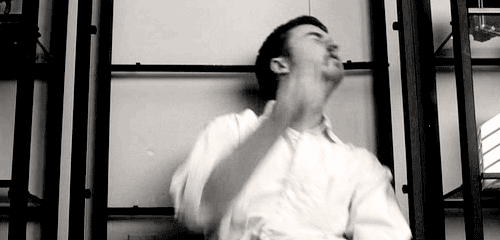Writing action scenes
I recently finished a book (one I won’t name because that’s just rude) in which the author strategically dodged action sequences while rolling through the plot. It was an adventure story. I expected action. Instead I received variations on “I won’t bore you with how we did it, but we emerged victorious.”
As a reader, I grumbled a lot while reading that book. As a writer, however, I can understand this calculated avoidance. Writing action sequences sucks. It’s hard work, exhausting and frustrating. And just when you think you’ve got it down, someone comes along and says “but when did the hero stand up?” Ugh.
There’s a lot to keep track of when writing action, combat or otherwise. Who’s doing what to whom, how and when can get pretty jumbled in a first draft, especially with more than two characters. If the scene is a fight, weapons that sounded awesome during brainstorming and outlining can because unwieldy or even useless, positioning can become a tactical nightmare and character behavior can seem inconsistent. Non-combat sequences can be even more trying. Their endings may not be clear or they simply lack appeal – running through a room is only so engaging, even if it’s integral to the plot.
Beyond that, it’s easy to get trapped in the simple, noun/verb/direct object sentence pattern: “She raised her sword. She slashed down. Her victim fell.” Short, punchy sentences give a sense of action and move the scene along, but reading a long line of them quickly becomes dull. (Writing too many is dull, too.)
Here’s a first draft excerpt from an action scene in the manuscript we’re currently finishing, working title The Things They Buried. Please forgive the first draft quality. It’s tough to read this now without fixing the obvious issues. (I’ve tried select a fragment that avoids spoilers.)
He grabbed for his blade, but she was too fast. Her body crashed against him, unsteadying him. He groped behind for balance, but found no support, instead stumbling into the music room. He slammed against the tile, feeling the bones of his left wrist shatter. He cried out and raised his right arm against the furious onslaught. The mutated woman leapt on top of him, clawing and tearing, shrieking and spitting. Syl twisted and threw her off. She came back at him low, driving him into the glass armonica. It tipped it over, shattering. Syl landed in the scattered glass, feeling the shards drive into his back and legs. Syl struggled to his feet. The thing dashed forward and grabbed a handful of his hair. She tugged angrily. Feeling roots let go, he spun and struck her square in the face with the heel of his good hand.
She staggered backward, shook her head and sprang forward, hugging him close. Arms pinned to his sides, he could not reach his dagger.
Here’s how it came out in the final draft:
He grabbed for the dagger nestled at his back, but she was too fast. She leaped onto him. He groped for balance, but finding none, pitched backward and slammed into the music room, lunatic monster riding him through the fall.
Something in his left wrist snapped when they hit the floor. He cried out and raised his right arm against her attack. She clawed and tore at him, shrieking and spitting with each swipe. Syl pressed knees into her gut and threw her off. He scrambled to his feet as she again bounced up. This time, she came at him low, crashing into his chest, driving him against the glass armonica, which tipped and shattered. Syl stumbled back, but kept his feet.
The woman-thing grabbed a handful of his hair and tugged, hissing something unintelligible. Feeling roots pull free, Syl twisted and struck her square in the face with the heel of his good hand. She staggered back, shook her head, then sprang forward, wrapping him in a fierce embrace that pinned his arms to his sides. He could not reach his dagger, could not strike at her, or do much more than pinch her thigh.
I think we went through about nine drafts to get to that point. Maybe more. The final version flows better and the word picture is clearer. With context of the rest of the story, it’s even better. I promise.
Michael and I write a lot of action in our Ismae stories, but I can’t say that I look forward to starting new sequences. I find, however, that the angst and effort is worth it. If done properly, a good action sequence makes a story more engaging and realistic and keeps the reader turning pages, eager to learn what happens next.


